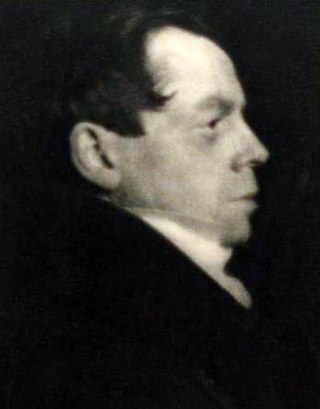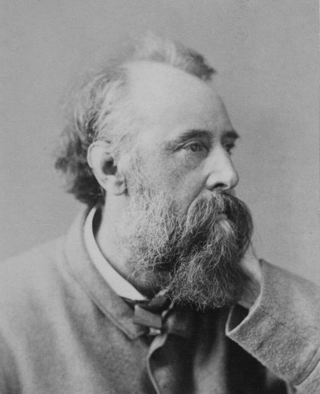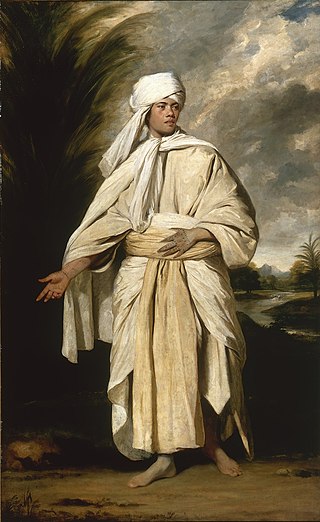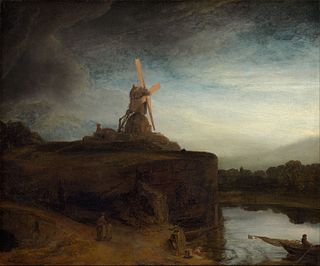
Sir Joshua Reynolds was an English painter who specialised in portraits. John Russell said he was one of the major European painters of the 18th century. He promoted the "Grand Style" in painting, which depended on idealisation of the imperfect. He was a founder and first president of the Royal Academy of Arts and was knighted by George III in 1769.

Thomas Gainsborough was an English portrait and landscape painter, draughtsman, and printmaker. Along with his rival Sir Joshua Reynolds, he is considered one of the most important British artists of the second half of the 18th century. He painted quickly, and the works of his maturity are characterised by a light palette and easy strokes. Despite being a prolific portrait painter, Gainsborough gained greater satisfaction from his landscapes. He is credited as the originator of the 18th-century British landscape school. Gainsborough was a founding member of the Royal Academy.

The National Gallery is an art museum in Trafalgar Square in the City of Westminster, in Central London, England. Founded in 1824, it houses a collection of more than 2,300 paintings dating from the mid-13th century to 1900. The current director of the National Gallery is Gabriele Finaldi.

Sir John Everett Millais, 1st Baronet was an English painter and illustrator who was one of the founders of the Pre-Raphaelite Brotherhood. He was a child prodigy who, aged eleven, became the youngest student to enter the Royal Academy Schools. The Pre-Raphaelite Brotherhood was founded at his family home in London, at 83 Gower Street. Millais became the most famous exponent of the style, his painting Christ in the House of His Parents (1849–50) generating considerable controversy, and he produced a picture that could serve as the embodiment of the historical and naturalist focus of the group, Ophelia, in 1851–52.

Maria Anna Angelika Kauffmann, usually known in English as Angelica Kauffman, was a Swiss Neoclassical painter who had a successful career in London and Rome. Remembered primarily as a history painter, Kauffmann was a skilled portraitist, landscape and decoration painter. She was, along with Mary Moser, one of two female painters among the founding members of the Royal Academy in London in 1768.

John Boydell was an English publisher noted for his reproductions of engravings. He helped alter the trade imbalance between Britain and France in engravings and initiated an English tradition in the art form. A former engraver himself, Boydell promoted the interests of artists as well as patrons and as a result his business prospered.

William Thomas Beckford was an English novelist, art critic, planter and politician. He was reputed at one stage to be England's richest commoner. The son of William Beckford and Maria Hamilton, daughter of the Hon. George Hamilton, he served as a Member of Parliament for Wells in 1784–1790 and Hindon in 1790–1795 and 1806–1820. Beckford is best known for writing the 1786 Gothic novel Vathek, for building the Fonthill Abbey in Wiltshire and Beckford's Tower in Bath, and for his extensive art collection.

Sir William Newzam Prior Nicholson was a British painter of still-life, landscape and portraits. He also worked as a printmaker in techniques including woodcut, wood-engraving and lithography, as an illustrator, as an author of children's books and as a designer for the theatre.

Benjamin West was a British-American artist who painted famous historical scenes such as The Death of Nelson, The Death of General Wolfe, the Treaty of Paris, and Benjamin Franklin Drawing Electricity from the Sky.

George Frederic Watts was a British painter and sculptor associated with the Symbolist movement. Watts became famous in his lifetime for his allegorical works, such as Hope and Love and Life. These paintings were intended to form part of an epic symbolic cycle called the "House of Life", in which the emotions and aspirations of life would all be represented in a universal symbolic language.

The Beaverbrook Art Gallery is a public art gallery in Fredericton, New Brunswick, Canada. It is named after William Maxwell "Max" Aitken, Lord Beaverbrook, who funded the building of the gallery and assembled the original collection. It opened in 1959 with over 300 works, including paintings by J. M. W. Turner and Salvador Dalí. The Beaverbrook Art Gallery is New Brunswick's officially designated provincial art gallery.

The Soviet sale of Hermitage paintings in 1930 and 1931 resulted in the departure of some of the most valuable paintings from the collection of the State Hermitage Museum in Leningrad to Western museums. Several of the paintings had been in the Hermitage Collection since its creation by Empress Catherine the Great. About 250 paintings were sold, including masterpieces by Jan van Eyck, Titian, Rembrandt, Rubens, Raphael, and other important artists. Andrew Mellon donated the twenty-one paintings he purchased from the Hermitage to the United States government in 1937, which became the nucleus of the National Gallery of Art in Washington, D.C.

Tate Britain, known from 1897 to 1932 as the National Gallery of British Art and from 1932 to 2000 as the Tate Gallery, is an art museum on Millbank in the City of Westminster in London, England. It is part of the Tate network of galleries in England, with Tate Modern, Tate Liverpool and Tate St Ives. Founded by Sir Henry Tate, it houses a substantial collection of the art of the United Kingdom since Tudor times, and in particular has large holdings of the works of J. M. W. Turner, who bequeathed all his own collection to the nation. It is one of the largest museums in the country. The museum had 525,144 visitors in 2021, an increase of 34 percent from 2020 but still well below pre- COVID-19 pandemic levels. In 2021 it ranked 50th on the list of most-visited art museums in the world.
Colnaghi is an art dealership in St James's, central London, England, which is the oldest commercial art gallery in the world, having been established in 1760.

The Lenox Library was a library incorporated and endowed in 1870. It was both an architectural and intellectual landmark in Gilded Age–era New York City. It was founded by bibliophile and philanthropist James Lenox, and located on Fifth Avenue between 70th and 71st Streets on the Upper East Side of Manhattan. Renowned architect Richard Morris Hunt designed the building, which was considered one of the city's most notable buildings, until its destruction in 1912.

Portrait of Mai (Omai) (also known as Portrait of Omai, Omai of the Friendly Isles or simply Omai) is an oil-on-canvas portrait of Omai, a Polynesian visitor to England, by Sir Joshua Reynolds, completed about 1776.
Lawrie & Co. was an art dealership and gallery in London, England.

Arthur Joseph Sulley was a London-based art dealer best known for selling Dutch Old Master paintings, including the record-setting Rembrandt van Rijn's The Mill.
Leo Dee was an American artist and teacher. A native of Newark, New Jersey, he achieved first regional and then national prominence for his "incredibly detailed" and realistic silverpoint drawings which conveyed "the softest and most subtle transitions of tonal values."
Jane, Lady Abdy was an English socialite and art dealer. She has been described as one of the most original and respected art dealers of her generation and opened British eyes to 19th-century French art. She is also credited for introducing many now revered 19th-century Danish artists to the international market.
















